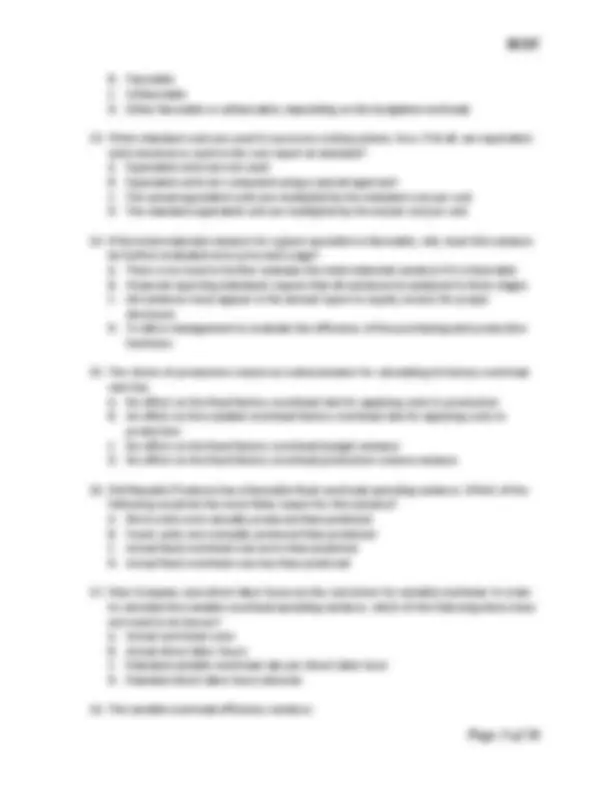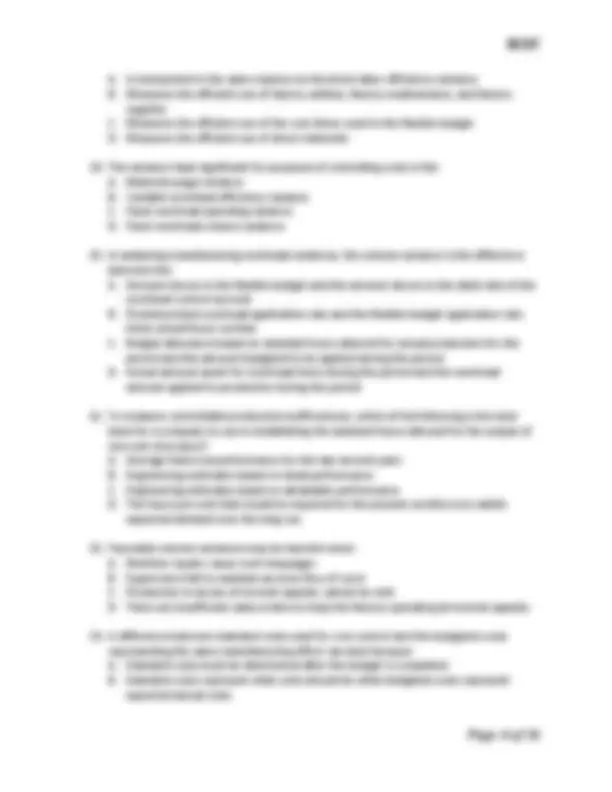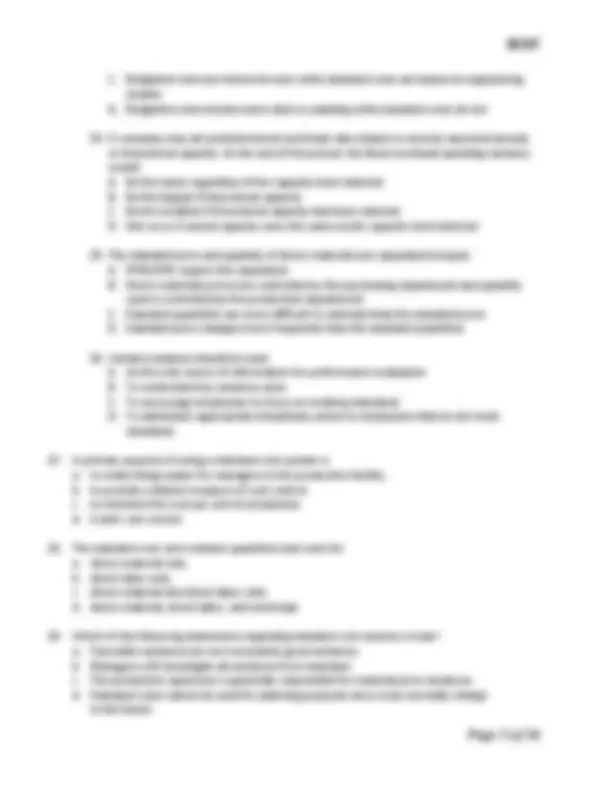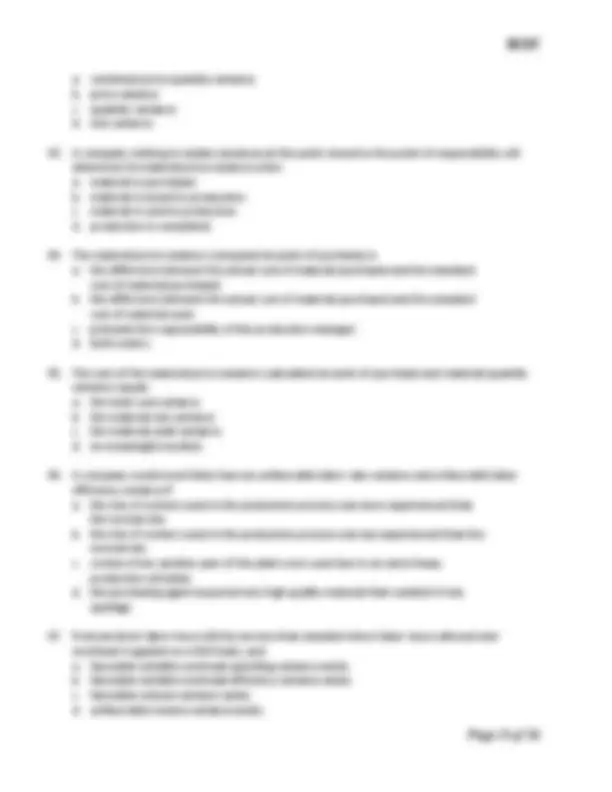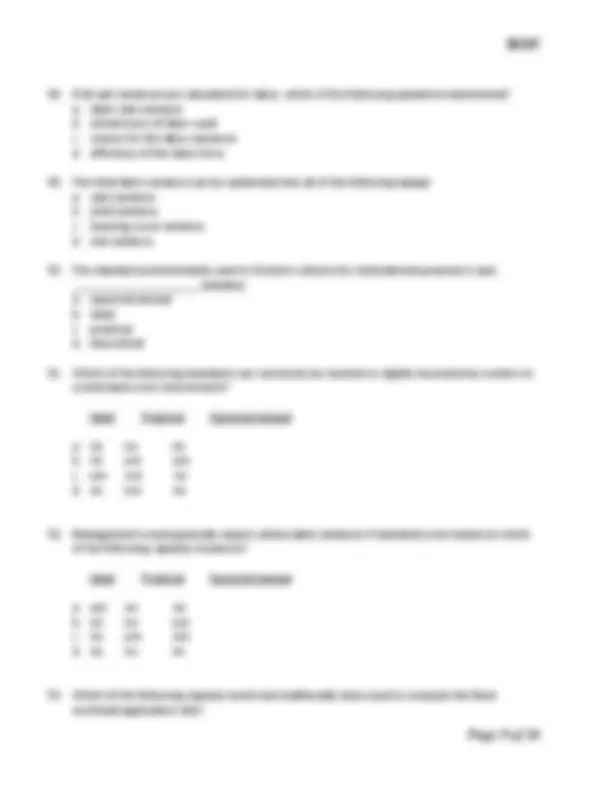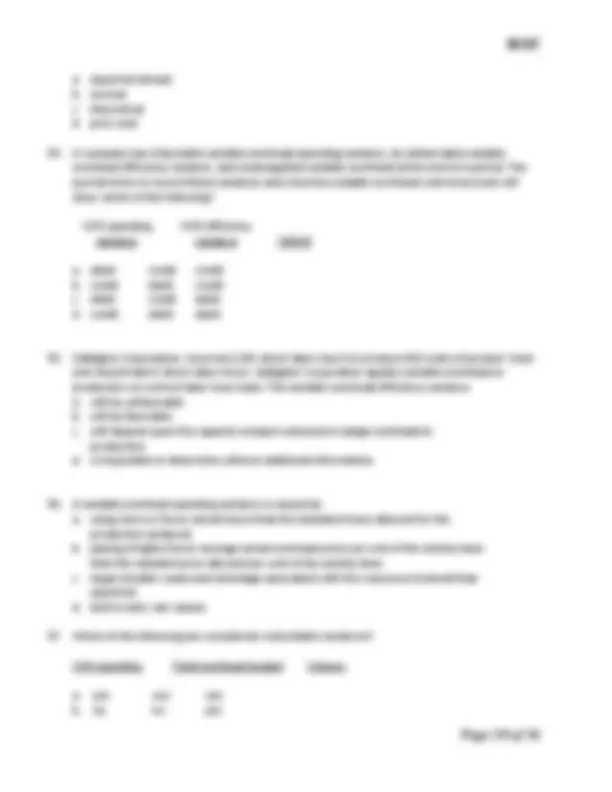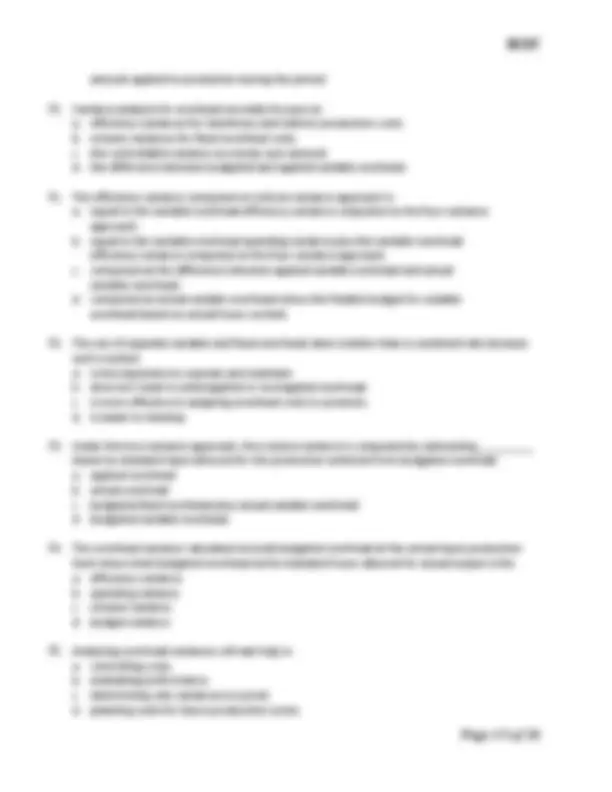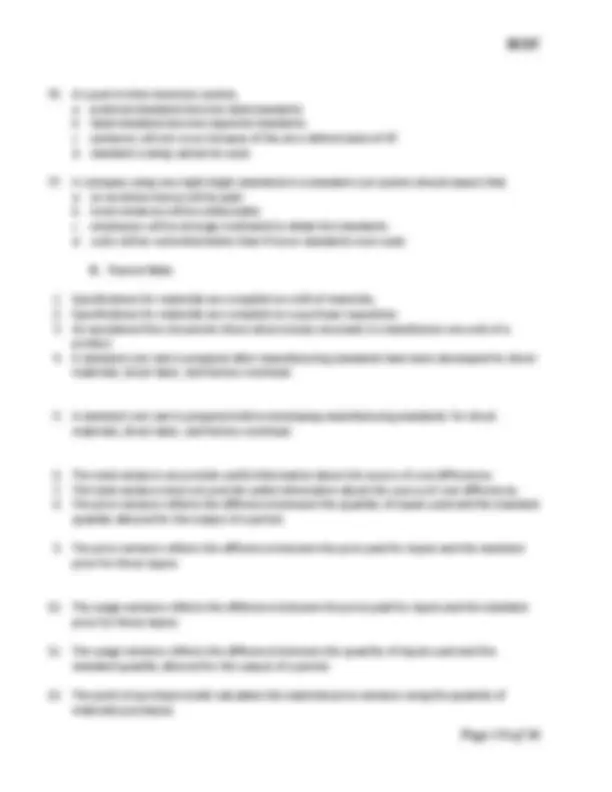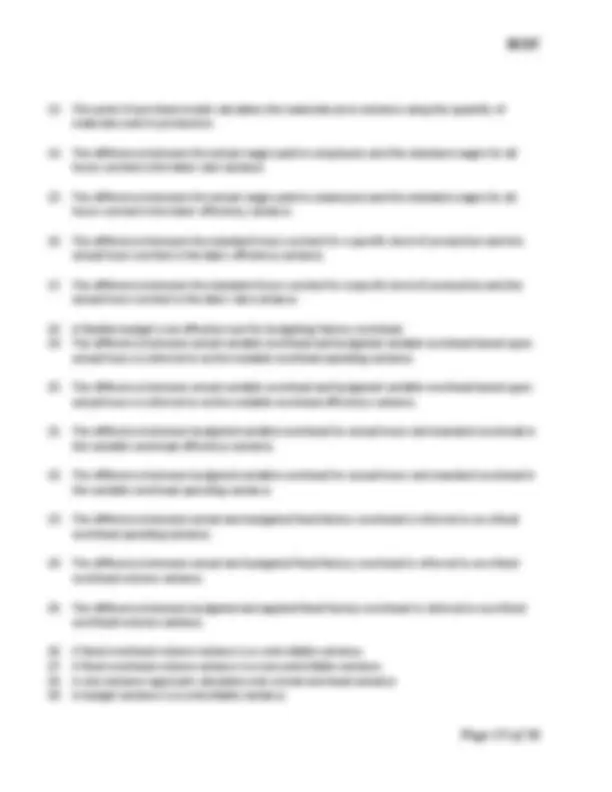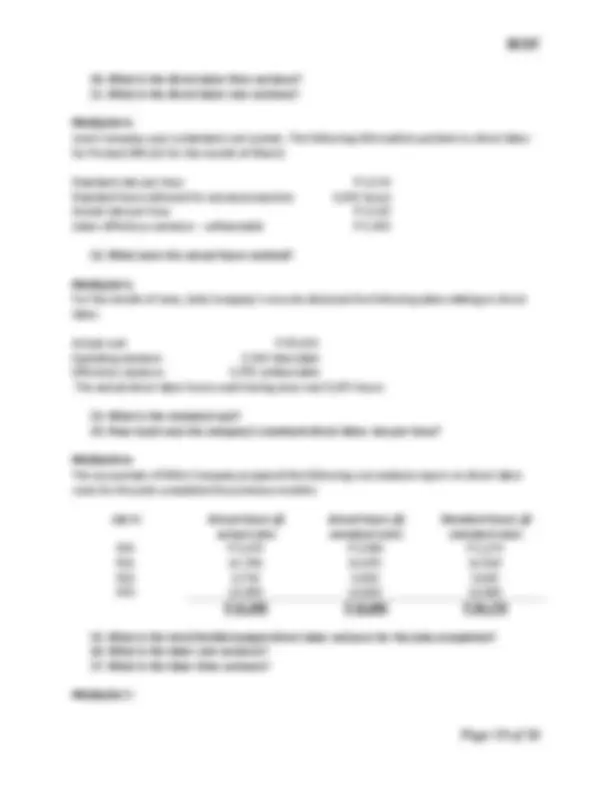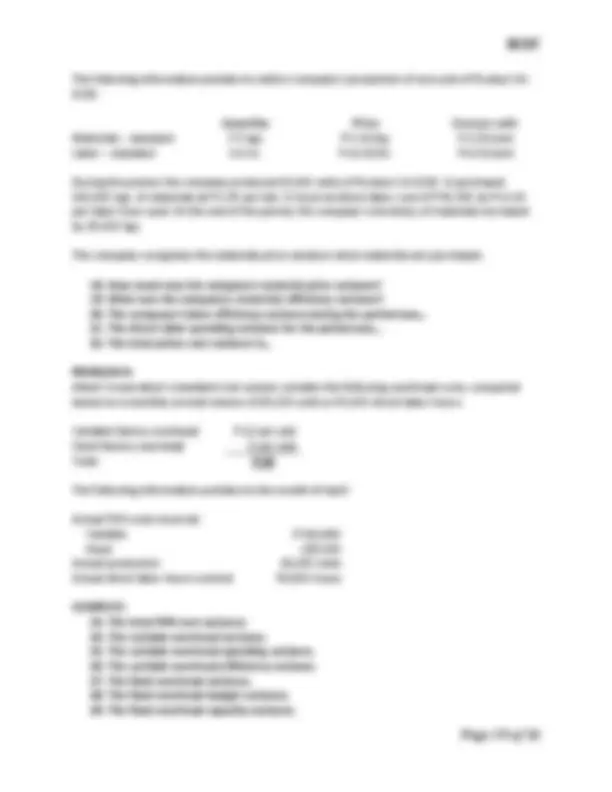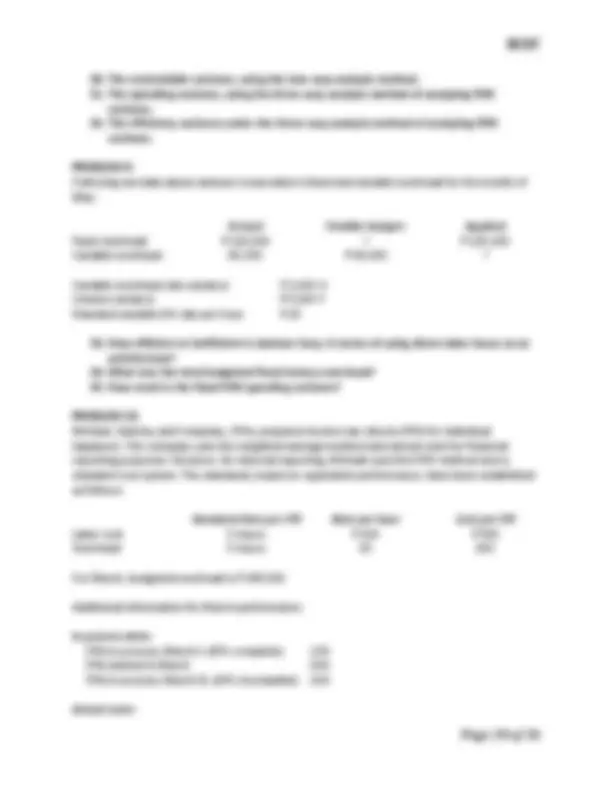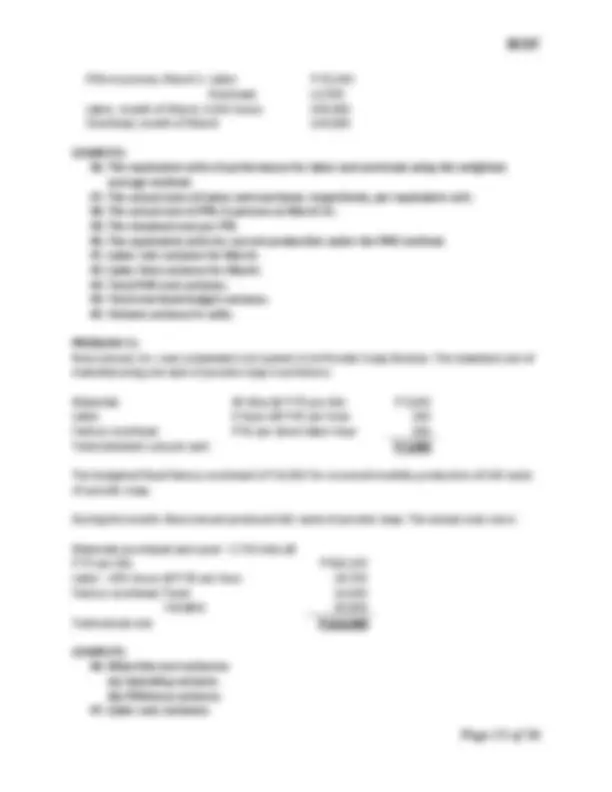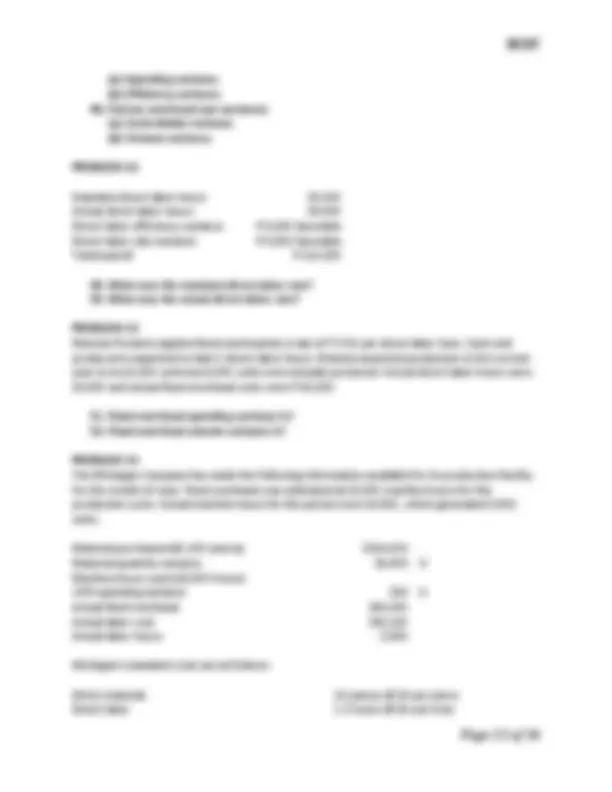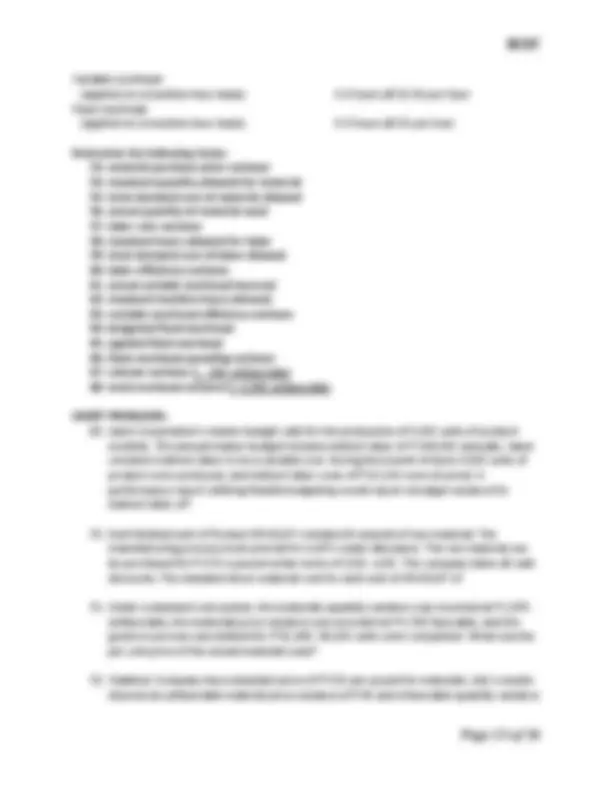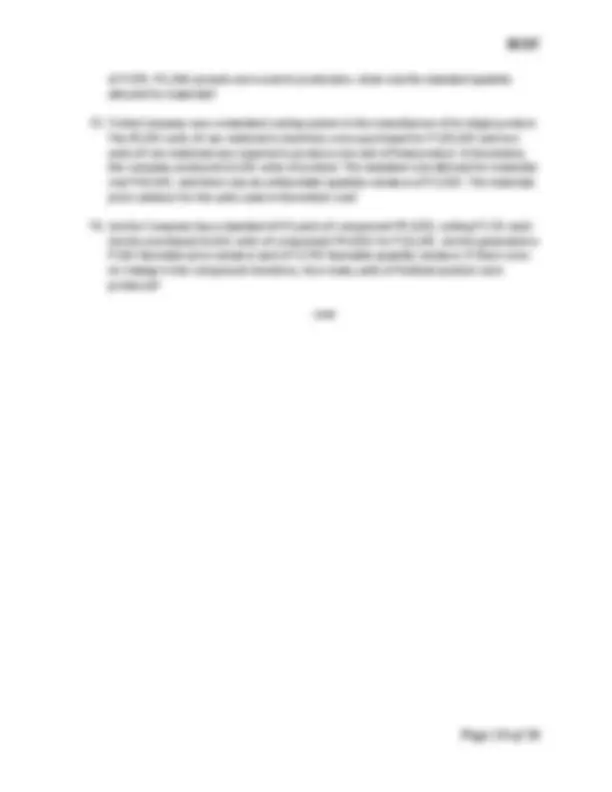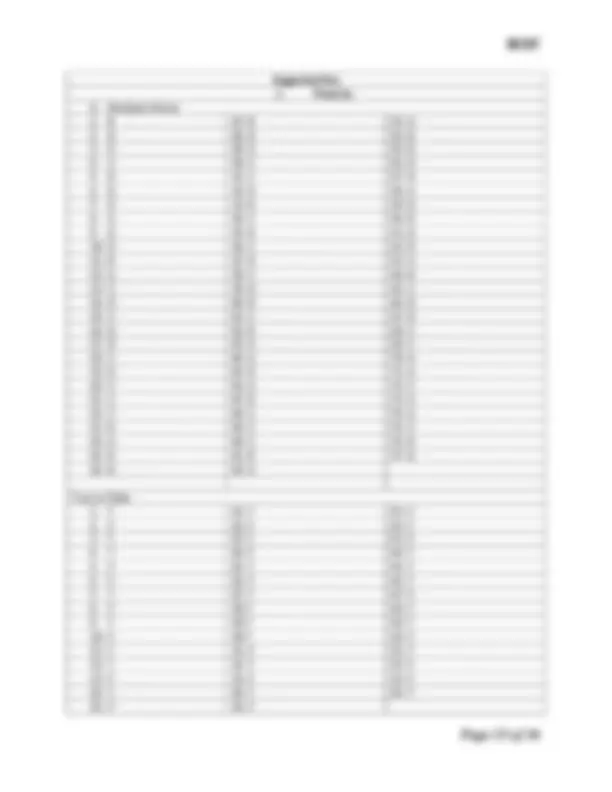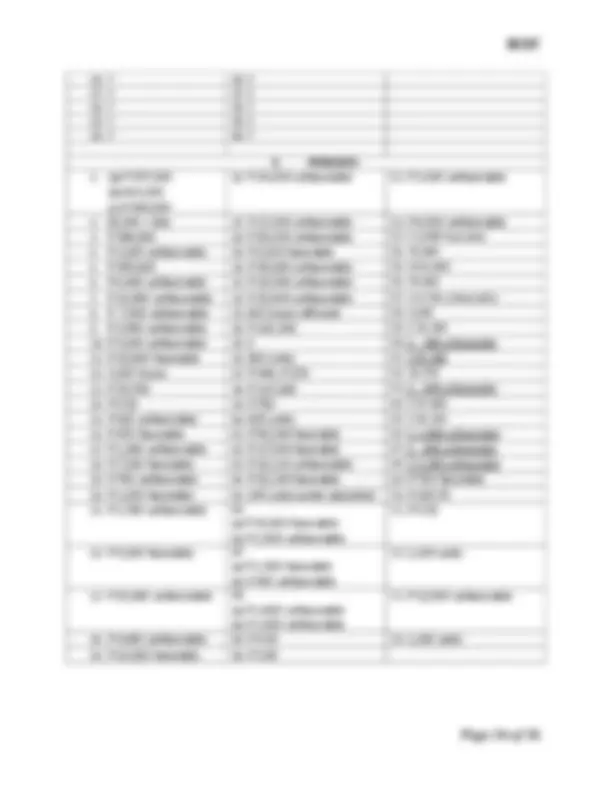Download Standard Costing: A Comprehensive Guide with Exercises and Problems and more Study notes Cost Accounting in PDF only on Docsity!
Standard Costing and Variance Analysis
Part I. THEORIES
A. Multiple Choice
- The primary purpose of using a standard cost system is to: A. Make things easier for managers in the production facility. B. Provide a distinct measure of cost control. C. Minimize the cost per unit of production. D. Assure continuous production of goods.
- When evaluating the operating performance, management sometimes uses the difference between the expected and actual performance. This refers to: A. Management by deviation B. Management by control C. Management by objective D. Management by exception
- Which of the following contains the two levels that standards may be set at? A. Normal and ideal B. Ideal and less efficient C. Normal and fully efficient D. Fully efficient and fully effective
- In most companies, machines break down occasionally and employees are often less than perfect. Which type of standard acknowledges these characteristics when determining the standard cost of a product? A. Efficiency standard B. Ideal standard C. Practical standard D. Budgeted standard
- A company employing very tight standards in a standard cost system should expect that A. No incentive bonus will be paid. B. Most variances will be unfavorable. C. Employees will be strongly motivated to attain the standard. D. Costs will be controlled better than if lower standards were used.
- Which department is customarily held responsible for an unfavorable materials usage variance? A. Quality control B. Engineering C. Purchasing
D. Production
- Standards that represent levels of operation that can be attained with reasonable effort are called: A. Theoretical standards B. Ideal standards C. Fixed standards D. Normal standards
- Which of the following is the most probable reason why a company would experience an unfavorable labor rate variance and a favorable labor efficiency variance? A. The mix of workers assigned to the particular job was heavily weighted toward the use of higher-paid, experienced individuals. B. The mix of workers assigned to the particular job was heavily weighted toward the use of new, relatively low paid, unskilled workers. C. Because of the productive schedule, workers from other production areas were assigned to assist in this particular process. D. Defective materials caused more labor to be used in order to produce a standard unit.
- The variance most useful in evaluating plant utilization is the: A. Variable overhead spending variance B. Fixed overhead spending variance C. Variable overhead efficiency variance D. Fixed overhead volume variance
- Which of the following statements is true regarding variance analysis in the modern manufacturing environment? A. It requires all variances, regardless of size, to be investigated by managers. B. The use of ideal standards over practical standards will always be the best motivator to employees. C. An unfavorable variance should always be interpreted as bad. D. It is often not performed in a timely enough manner to be useful to employees.
- A manufacturer generally wants to set a standard that: A. Can be achieved only under the most efficient operating conditions. B. Is high enough to provide motivation and promote efficiency, but is still attainable. C. Makes no allowance for normal spoilage. D. None of these.
- The fixed overhead application rate is a function of a predetermined normal activity level. If standard hours allowed for good output equal this predetermined activity level for a given period, the volume variance will be: A. Zero
A. Is interpreted in the same manner as the direct labor efficiency variance B. Measures the efficient use of factory utilities, factory maintenance, and factory supplies C. Measures the efficient use of the cost driver used in the flexible budget D. Measures the efficient use of direct materials
- The variance least significant for purposes of controlling costs is the: A. Material usage variance B. Variable overhead efficiency variance C. Fixed overhead spending variance D. Fixed overhead volume variance
- In analyzing manufacturing overhead variances, the volume variance is the difference between the: A. Amount shown in the flexible budget and the amount shown in the debit side of the overhead control account B. Predetermined overhead application rate and the flexible budget application rate times actual hours worked C. Budget allowance based on standard hours allowed for actual production for the period and the amount budgeted to be applied during the period D. Actual amount spent for overhead items during the period and the overhead amount applied to production during the period
- To measure controllable production inefficiencies, which of the following is the best basis for a company to use in establishing the standard hours allowed for the output of one unit of product? A. Average historical performance for the last several years B. Engineering estimates based on ideal performance C. Engineering estimates based on attainable performance D. The hours per unit that would be required for the present workforce to satisfy expected demand over the long run
- Favorable volume variances may be harmful when: A. Machine repairs cause work stoppages B. Supervisors fail to maintain an even flow of work C. Production in excess of normal capacity cannot be sold D. There are insufficient sales orders to keep the factory operating at normal capacity
- A difference between standard costs used for cost control and the budgeted costs representing the same manufacturing effort can exist because: A. Standard costs must be determined after the budget is completed B. Standard costs represent what costs should be while budgeted costs represent expected actual costs
C. Budgeted costs are historical costs while standard costs are based on engineering studies D. Budgeted costs include some slack or padding while standard costs do not
- A company may set predetermined overhead rates based on normal, expected annual, or theoretical capacity. At the end of the period, the fixed overhead spending variance would: A. Be the same regardless of the capacity level selected B. Be the largest if theoretical capacity C. Be the smallest if theoretical capacity had been selected D. Not occur if actual capacity were the same as the capacity level selected
- The standard price and quantity of direct materials are separated because: A. PFRS/IFRS require this separation B. Direct materials prices are controlled by the purchasing department and quantity used is controlled by the production department C. Standard quantities are more difficult to estimate than the standard price D. Standard price changes more frequently than the standard quantities
- Variance analysis should be used A. As the only source of information for performance evaluation B. To understand by variances arise C. To encourage employees to focus on meeting standards D. To administer appropriate disciplinary action to employees that do not meet standards
- A primary purpose of using a standard cost system is a. to make things easier for managers in the production facility. b. to provide a distinct measure of cost control. c. to minimize the cost per unit of production. d. b and c are correct.
- The standard cost card contains quantities and costs for a. direct material only. b. direct labor only. c. direct material and direct labor only. d. direct material, direct labor, and overhead.
- Which of the following statements regarding standard cost systems is true? a. Favorable variances are not necessarily good variances. b. Managers will investigate all variances from standard. c. The production supervisor is generally responsible for material price variances. d. Standard costs cannot be used for planning purposes since costs normally change in the future.
the delivery of the finished product. c. specifies tasks to make a unit and the times allowed for each task. d. charts the shortest path by which to arrange machines for completing products.
- A total variance is best defined as the difference between total a. actual cost and total cost applied for the standard output of the period. b. standard cost and total cost applied to production. c. actual cost and total standard cost of the actual input of the period. d. actual cost and total cost applied for the actual output of the period.
- The term standard hours allowed measures a. budgeted output at actual hours. b. budgeted output at standard hours. c. actual output at standard hours. d. actual output at actual hours.
- A large labor efficiency variance is prorated to which of the following at year-end?
WIP FG Cost of Goods Sold Inventory Inventory
a. no no no b. no yes yes c. yes no no d. yes yes yes
- Which of the following factors should not be considered when deciding whether to investigate a variance? a. magnitude of the variance b. trend of the variances over time c. likelihood that an investigation will reduce or eliminate future occurrences of the variance d. whether the variance is favorable or unfavorable
- At the end of a period, a significant material quantity variance should be a. closed to Cost of Goods Sold. b. allocated among Raw Material, Work in Process, Finished Goods, and Cost of Goods Sold. c. allocated among Work in Process, Finished Goods, and Cost of Goods Sold. d. carried forward as a balance sheet account to the next period.
- When computing variances from standard costs, the difference between actual and standard price multiplied by actual quantity used yields a
a. combined price-quantity variance. b. price variance. c. quantity variance. d. mix variance.
- A company wishing to isolate variances at the point closest to the point of responsibility will determine its material price variance when a. material is purchased. b. material is issued to production. c. material is used in production. d. production is completed.
- The material price variance (computed at point of purchase) is a. the difference between the actual cost of material purchased and the standard cost of material purchased. b. the difference between the actual cost of material purchased and the standard cost of material used. c. primarily the responsibility of the production manager. d. both a and c.
- The sum of the material price variance (calculated at point of purchase) and material quantity variance equals a. the total cost variance. b. the material mix variance. c. the material yield variance. d. no meaningful number.
- A company would most likely have an unfavorable labor rate variance and a favorable labor efficiency variance if a. the mix of workers used in the production process was more experienced than the normal mix. b. the mix of workers used in the production process was less experienced than the normal mix. c. workers from another part of the plant were used due to an extra heavy production schedule. d. the purchasing agent acquired very high quality material that resulted in less spoilage.
- If actual direct labor hours (DLHs) are less than standard direct labor hours allowed and overhead is applied on a DLH basis, a(n) a. favorable variable overhead spending variance exists. b. favorable variable overhead efficiency variance exists. c. favorable volume variance exists. d. unfavorable volume variance exists.
a. expected annual b. normal c. theoretical d. prior year
- A company has a favorable variable overhead spending variance, an unfavorable variable overhead efficiency variance, and underapplied variable overhead at the end of a period. The journal entry to record these variances and close the variable overhead control account will show which of the following?
VOH spending variance
VOH efficiency variance VMOH
a. debit credit credit b. credit debit credit c. debit credit debit d. credit debit debit
- Gallagher Corporation. incurred 2,300 direct labor hours to produce 600 units of product. Each unit should take 4 direct labor hours. Gallagher Corporation applies variable overhead to production on a direct labor hour basis. The variable overhead efficiency variance a. will be unfavorable. b. will be favorable. c. will depend upon the capacity measure selected to assign overhead to production. d. is impossible to determine without additional information.
- A variable overhead spending variance is caused by a. using more or fewer actual hours than the standard hours allowed for the production achieved. b. paying a higher/lower average actual overhead price per unit of the activity base than the standard price allowed per unit of the activity base. c. larger/smaller waste and shrinkage associated with the resources involved than expected. d. both b and c are causes.
- Which of the following are considered controllable variances?
VOH spending Total overhead budget Volume
a. yes yes yes b. no no yes
c. no yes no d. yes yes no
- A company may set predetermined overhead rates based on normal, expected annual, or theoretical capacity. At the end of a period, the fixed overhead spending variance would a. be the same regardless of the capacity level selected. b. be the largest if theoretical capacity had been selected. c. be the smallest if theoretical capacity had been selected. d. not occur if actual capacity were the same as the capacity level selected.
- The variance least significant for purposes of controlling costs is the a. material quantity variance. b. variable overhead efficiency variance. c. fixed overhead spending variance. d. fixed overhead volume variance.
- Fixed overhead costs are a. best controlled on a unit-by-unit basis of products produced. b. mostly incurred to provide the capacity to produce and are best controlled on a total basis at the time they are originally negotiated. c. constant on a per-unit basis at all different activity levels within the relevant range. d. best controlled as to spending during the production process.
- The variance most useful in evaluating plant utilization is the a. variable overhead spending variance. b. fixed overhead spending variance. c. variable overhead efficiency variance. d. fixed overhead volume variance.
- A favorable fixed overhead volume variance occurs if a. there is a favorable labor efficiency variance. b. there is a favorable labor rate variance. c. production is less than planned. d. production is greater than planned.
- The fixed overhead application rate is a function of a predetermined activity level. If standard hours allowed for good output equal the predetermined activity level for a given period, the volume variance will be a. zero. b. favorable. c. unfavorable. d. either favorable or unfavorable, depending on the budgeted overhead.
amount applied to production during the period.
- Variance analysis for overhead normally focuses on a. efficiency variances for machinery and indirect production costs. b. volume variances for fixed overhead costs. c. the controllable variance as a lump-sum amount. d. the difference between budgeted and applied variable overhead.
- The efficiency variance computed on a three-variance approach is a. equal to the variable overhead efficiency variance computed on the four-variance approach. b. equal to the variable overhead spending variance plus the variable overhead efficiency variance computed on the four-variance approach. c. computed as the difference between applied variable overhead and actual variable overhead. d. computed as actual variable overhead minus the flexible budget for variable overhead based on actual hours worked.
- The use of separate variable and fixed overhead rates is better than a combined rate because such a system a. is less expensive to operate and maintain. b. does not result in underapplied or overapplied overhead. c. is more effective in assigning overhead costs to products. d. is easier to develop.
- Under the two-variance approach, the volume variance is computed by subtracting _________ based on standard input allowed for the production achieved from budgeted overhead. a. applied overhead b. actual overhead c. budgeted fixed overhead plus actual variable overhead d. budgeted variable overhead
- The overhead variance calculated as total budgeted overhead at the actual input production level minus total budgeted overhead at the standard hours allowed for actual output is the a. efficiency variance. b. spending variance. c. volume variance. d. budget variance.
- Analyzing overhead variances will not help in a. controlling costs. b. evaluating performance. c. determining why variances occurred. d. planning costs for future production cycles.
- In a just-in-time inventory system, a. practical standards become ideal standards. b. ideal standards become expected standards. c. variances will not occur because of the zero-defects basis of JIT. d. standard costing cannot be used.
- A company using very tight (high) standards in a standard cost system should expect that a. no incentive bonus will be paid. b. most variances will be unfavorable. c. employees will be strongly motivated to attain the standards. d. costs will be controlled better than if lower standards were used.
B. True or False
- Specifications for materials are compiled on a bill of materials.
- Specifications for materials are compiled on a purchase requisition.
- An operations flow document shows all processes necessary to manufacture one unit of a product.
- A standard cost card is prepared after manufacturing standards have been developed for direct materials, direct labor, and factory overhead.
- A standard cost card is prepared before developing manufacturing standards for direct materials, direct labor, and factory overhead.
- The total variance can provide useful information about the source of cost differences.
- The total variance does not provide useful information about the source of cost differences.
- The price variance reflects the difference between the quantity of inputs used and the standard quantity allowed for the output of a period.
- The price variance reflects the difference between the price paid for inputs and the standard price for those inputs.
- The usage variance reflects the difference between the price paid for inputs and the standard price for those inputs.
- The usage variance reflects the difference between the quantity of inputs used and the standard quantity allowed for the output of a period.
- The point of purchase model calculates the materials price variance using the quantity of materials purchased.
- An overhead efficiency variance is related entirely to variable overhead
- Managers have no ability to control the budget variance,
- Unfavorable variances are represented by debit balances in the overhead account.
- Unfavorable variances are represented by credit balances in the overhead account.
- Favorable variances are represented by credit balances in the overhead account.
- Favorable variances are represented by debit balances in the overhead account.
- Favorable variances are always desirable for production.
- Expected standards are a valuable tool for motivation and control.
- Practical standards are the most effective standards for controlling and motivating workers.
- Ideal standards are an effective means of controlling variances and motivating workers.
- Ideal standards do not allow for normal operating delays or human limitations.
- Expected standards generally yield unfavorable variances
- Expected standards generally yield favorable variances
- Ideal standards generally yield favorable variances
- Ideal standards generally yield unfavorable variances
- Total quality management (TQM) and just-in-time (JIT) production systems are based on the premise of ideal production standards.
- In a totally automated organization, using theoretical capacity will generally provide the lowest fixed overhead application rate.
- In a totally automated organization, using theoretical capacity will generally provide the highest fixed overhead application rate.
- A conversion variance combines labor and overhead variances.
- The effect of substituting a non-standard mix of materials during the production process is referred to as a material mix variance.
- The effect of substituting a non-standard mix of materials during the production process is referred to as a material yield variance.
- When multiple labor categories are used, the financial effect of using a different mix of workers in a production process is referred to as a labor mix variance.
- When multiple labor categories are used, the financial effect of using a different mix of workers in a production process is referred to as a labor yield variance.
- When multiple labor categories are used, the monetary impact of using a higher or lower number of hours than a standard allows is referred to as a labor mix variance.
- When multiple labor categories are used, the monetary impact of using a higher or lower number of hours than a standard allows is referred to as a labor yield variance.
Part II. PROBLEMS
PROBLEM 1:
Sam Company produces a product with the following standard costs:
Materials, 2 pieces @ P 5 per piece P 10 Labor, 4 hours @ P 8 per hour 32 Variable overhead, 4 hours @ P 6 per hour 24 Fixed overhead, 4 hours @ P 4 per hour * 16 Total standard manufacturing cost per unit P 82
- based on a capacity level of 5,000 units
1. If a flexible budget for (a) 4,500 units (b) 5,000 units and (c) 5,500 units is prepared for **a certain month, the budgeted costs are?
- What is the flexible budget formula that the company may use to compute total** **budgeted cost for any value of X within the relevant range?
- Assume that during the month, the company actually produced 4,800 units and** incurred actual total manufacturing costs of P 400,000, how much is the flexible **budget for the actual production?
- How much is the flexible budget variance for the month? (indicate whether the** **difference favorable or unfavorable)
- How much is the total standard cost that should have been incurred for the actual** **production of 4,800 units?
- How much is the total standard cost variance? (indicate whether the difference is** favorable or unfavorable)
PROBLEM 2: During July, Pringles company’s direct materials costs for the production of Product A4 were as follows:
Standard unit price P 12. Standard quantity allowed for actual production 6,300 units Actual unit purchase price P 13 Quantity purchased and used for actual production 6,900 units
**7. The total materials cost variance is…
- The materials efficiency variance is…
- The materials spending variance is…**
PROBLEM 3: Aby Company produced 3,200 units of product. Each unit requires 2 standard hours. The standard labor rate is P 15 per hour. Actual direct labor for the period was P 79,200 (6, hours x P 12).
The following information pertains to Jethro Company’s production of one unit of Product CA- 0138:
Quantity: Price: Cost per unit: Materials – standard 7.5 kgs. P 0.30/kg. P 2.25/unit Labor – standard 0.6 hr. P 10.00/hr. P 6.00/unit
During the period, the company produced 15,000 units of Product CA-0138. It purchased 140,000 kgs. of materials at P 0.25 per kilo. It incurred direct labor cost of P 90,780 at P 10. per labor hour used. At the end of the period, the company’s inventory of materials increased by 25,000 kgs.
The company recognizes the materials price variance when materials are purchased.
**18. How much was the company’s material price variance?
- What was the company’s materials efficiency variance?
- The company’s labor efficiency variance during the period was…
- The direct labor spending variance for the period was…
- The total prime cost variance is…**
PROBLEM 8: Albert Corporation’s standard cost system contains the following overhead costs, computed based on a monthly normal volume of 25,000 units or 50,000 direct labor hours:
Variable factory overhead P 12 per unit Fixed factory overhead 8 per unit Total P 20
The following information pertains to the month of April:
Actual FOH costs incurred: Variable P 316, Fixed 225, Actual production 26,000 units Actual direct labor hours worked 54,600 hours
COMPUTE:
**23. The total FOH cost variance.
- The variable overhead variance.
- The variable overhead spending variance.
- The variable overhead efficiency variance.
- The fixed overhead variance.
- The fixed overhead budget variance.
- The fixed overhead capacity variance.**
**30. The controllable variance, using the two-way analysis method.
- The spending variance, using the three-way analysis method of analyzing FOH** **variance.
- The efficiency variance under the three-way analysis method of analyzing FOH** variance.
PROBLEM 9: Following are data about Jamison Corporation’s fixed and variable overhead for the month of May:
Actual: Flexible budget: Applied: Fixed overhead P 120,000? P 125, Variable overhead 80,000 P 90,000?
Variable overhead rate variance P 2,000 U Volume variance P 5,000 F Standard variable OH rate per hour P 20
33. How efficient or inefficient is Jamison Corp. in terms of using direct labor hours as an **activity base?
- What was the total budgeted fixed factory overhead?
- How much is the fixed FOH spending variance?**
PROBLEM 10: Michael, Katrina, and Company, CPAs, prepares income tax returns (ITR) for individual taxpayers. The company uses the weighted-average method and actual costs for financial reporting purposes. However, for internal reporting, Michael uses the FIFO method and a standard cost system. The standards, based on equivalent performance, have been established as follows:
Standard time per ITR Rate per hour Cost per ITR Labor cost 5 hours P 100 P 500 Overhead 5 hours 50 250
For March, budgeted overhead is P 245,000.
Additional information for March performance:
In-process data: ITRs in process, March 1 (25% complete) 100 ITRs started in March 800 ITRs in process, March 31 (20% incomplete) 200
Actual costs:

